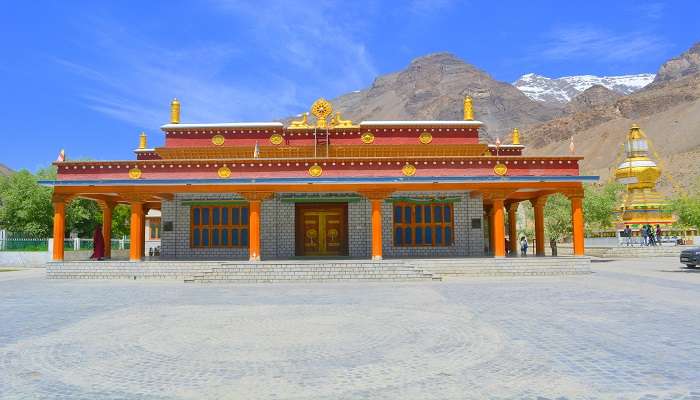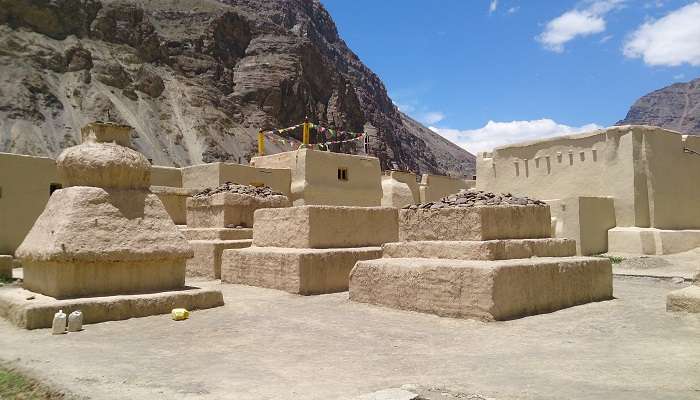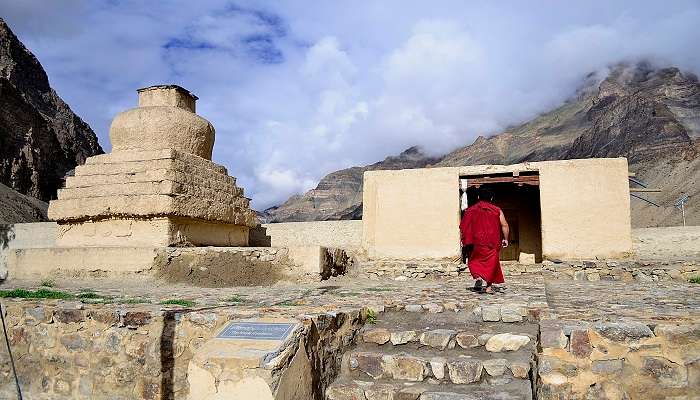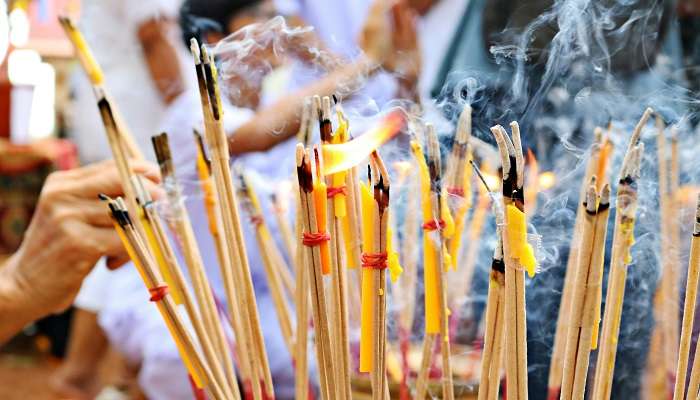The Tabo Monastery stands as a testament to the enduring spirit of Tibetan Buddhism and has served as a beacon of spiritual enlightenment and a hub of cultural preservation for over a millennium amidst the Spiti Valley’s rugged peaks and pristine landscapes. This ancient sanctuary was founded in 996 CE and has weathered the sands of time. As you approach the monastery, the smell of incense and lamas singing out loud create a unique atmosphere. Your feelings cannot be bypassed by watching painted tall and slim walls with their deep carvings and ornaments as if they were silently speaking about the long-lasting and significant past of the place.
Uncovering The Monastery’s Rich History

Image Credit: Shubhraiam for wikimedia commons
Tabo Monastery was established by the Tibetan Buddhist translator Rinchen Zangpo in 996 CE under the blessing of Yeshe-Ö, the Guge king. During this time, Buddhism’s second significant spread within Tibet was crucial in such cultural and religious revival. Throughout its history, there have been plenty of ups and downs at the monastery, starting with the fights in the 17th-19th centuries, including wars between monks themselves and ending with conflict with local authorities in the 20th century while still surviving, which indicates how strong and flexible the Tibetan Buddhist tradition is.
In 2000, the Dalai Lama himself presided over one of the most important events in Tabo’s recent history—the Kalachakra empowerment ceremony. This great event drew thousands of Buddhist devotees from different parts of the globe, reflecting on the monastery’s persistent value as a spiritual hub.
Must Read: Places To Visit In Himachal Pradesh
Explore The Architectural Splendour

Image Credit: Manish Pathak for wikimedia commons
The Tabo Monastery complex is an exemplary work of art in Himalayan structural design that combines various aspects of Tibetan, Indian, and Kashmiri architecture. The heart of this assembly is the Tsug Lhakhang, or Main Assembly Hall, which is regarded as the most critical building ever erected here. The detail in the iconography is truly spectacular; these powerful symbols make me ponder a lot. Tabo Monastery is the Ajanta of the Himalayas because it is compared to the great cave paintings at Ajanta in India.
The interior will delight your senses; detailed murals, sculptures, and inscriptions cover the walls and ceilings. On the central altar stands an enormous Vairocana statue, the emanation of the cosmic Buddha. Buddhas Amitabha, Amoghasiddhi, Akshobya and Ratnasambhava stand around, each headwater, in turn, having different contents of enlightenment; hence, each arises from a separate foundation. The arrangement of statues and paintings in the “Vajradhatu” mandala proves that this monastery follows the Buddhist Mahayana and Vajrayana traditions. Created by the play of light and shadow penetrating the small ceiling windows, the sun fills the space with a suggestive sense of contemplation and worship.
The Monastic Life and Education

Image Credit:Arup1981 for wikimedia commons
The Tabo Monastery’s day-to-day existence is a happy combination of spiritual discipline and academic study. Here, the lamas chant mantras and enact tantric rites as part of their morning rituals, maintaining the age-old standards set by the Gelugpa school’s tradition.
However, Tabo is more than just a place for worship. It also serves as a centre of education and enlightenment. Operating within this monastic establishment is Serkong School, which accommodates an impressive 270 students through an all-around curriculum that covers subjects such as language and mathematics, information technology, and art. The School’s mission is to protect the rich cultural and linguistic heritage of Spiti Valley while also enabling the next generation to thrive in this rapidly globalizing world. It demonstrates the monastery’s dedication to an all-round education that empowers its local community.
Suggested Read: Secret Places In Himachal
Festivals and Celebrations

Image Credit: CFynn for wikimedia commons
Throughout the year, vibrant celebrations bring together devotees and tourists from far and wide in Tabo Monastery. Among them is the most outstanding: The Chakhar Festival, held every three years, comprises traditional Buddhist music, regional dances, songs, and religious masked performances. Drums fill the air with rhythmic beats, while lamas chant melodically to create an atmosphere of pure happiness mixed with worship in holy places where God dwells. In the morning, you can see a ritual that is repeated daily, which is called puja. The clipping technique occurs when they devise chants for their devotion as a group of lamas.
It is only mesmerizing how each monk adds his unique style and arrangement using their voice to develop a tapestry of sound over time. Deep-seated traditions handed over the years are believed to be the theme of those actions.
Spiritual Significance

Tabo Monastery is cherished by Buddhists, who see it as a place where they can cleanse their body, mind, and soul. They also say there’s a sacred statue of Buddha, which has some power to heal the sick or wounded. They also talk about some spiritual beings that live within that place because locals worship them. Throughout the year, the lamas engage in various rites, including the annual Kalachakra initiation in 2000, attended by the Dalai Lama himself. These acts are critical in making people from all over the world on pilgrimage come here. They also help ensure continuity in the region’s cultural values, which have developed over time.
The Tabo Monastery is an unforgettable place. Please come and visit whether you are very religious, a tourist inquisitive about Buddhism, or someone who just wants some peace. After leaving the sacred buildings, their memories will never fade away from your mind. This is evidence of how strong the human spirit can be when guided through teachings that never fade away, even for centuries, like warp-conductor light paths across space-time formed within it during the Big Bang.
Further Read: Hill Stations In Himachal
Now that you have a list of things to keep in mind for your next vacation to enjoy at Tabo Monastery, make sure you plan your trip to Himachal Pradesh to these fabulous spots accompanied by your loved ones; this experience will be more rewarding as you experience all the fun with them. Don’t miss out on these opportunities and book your tickets now!
For our editorial codes of conduct and copyright disclaimer, please click here.
Cover Image Credit:Vikramjit Kakati for wikimedia commons
Frequently Asked Questions About Tabo Monastery
How do visitors get to Tabo Monastery?
Tabo Monastery is accessible through the Rohtang Pass and Kunzum Pass or through the strips of land called Kinnaur Valley from Manali and Shimla respectively. The airport that is located nearest to it is Bhuntar which is situated near Kullu whereas Shimla is the nearest train station to Tabo Monastery.
When can I visit Tabo Monastery best?
The period to visit is between May to October which has favourable weather conditions and accessible roads. Winter months are not recommended because it’s extremely cold with too much snow.
Is it possible for tourists to spend a night at the Tabo Monastery?
Yes, tourists are allowed to spend a night there. Among the visitors, guesthouses are offered to ensure they have such an important impression of monastic life in the closest way possible experience. Make sure that you book accommodation early enough particularly when it is time for tourists because the capacity might be inadequate.
What attracts people the most in Tabo Monastery?
The main attractions here are painted ancient murals, thangkas on silk and stuccos that tell Buddhist stories. Also, there are valuable scrolls, manuscripts and statues in the monastery.
Does the Tabo Monastery have any unique celebrations?
Yes, at the Tabo Monastery, several festivals are celebrated although the 'Chakhar Mela' is the most important festival celebrated at the Tabo Monastery every three years with masked dances and religious ceremonies.
People Also Read:
Namgyal Monastery Namdroling Monastery Ritigala Forest Monastery

Passionate Marketing Student with a flair for storytelling, eagerly embarking on a journey within the vibrant world of travel. Excited to merge analytical acumen with creative skills to elevate the editorial landscape of the travel industry.











